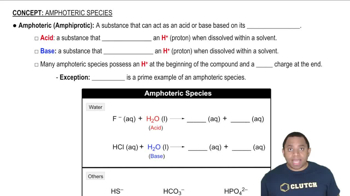Here are the essential concepts you must grasp in order to answer the question correctly.
Amphoteric Substances
Amphoteric substances are compounds that can act as both acids and bases depending on the environment. This dual behavior allows them to either donate protons (H+) in acidic conditions or accept protons in basic conditions. Understanding this property is crucial for predicting the reactions of substances like HCO3- and HS- in various chemical contexts.
Recommended video:
Acid-Base Reactions
Acid-base reactions involve the transfer of protons between reactants. An acid is defined as a proton donor, while a base is a proton acceptor. In the context of HCO3- and HS-, writing equations that illustrate their behavior as acids and bases requires recognizing how they interact with other species in solution, such as water or other acids and bases.
Recommended video:
Chemical Equations
Chemical equations represent the reactants and products in a chemical reaction, providing a concise way to illustrate the changes that occur. For amphoteric substances, writing balanced equations that show their acid and base behavior involves ensuring that the number of atoms and charge is conserved. This skill is essential for accurately depicting the reactions of HCO3- and HS-.
Recommended video:
Balancing Chemical Equations
 Verified step by step guidance
Verified step by step guidance

